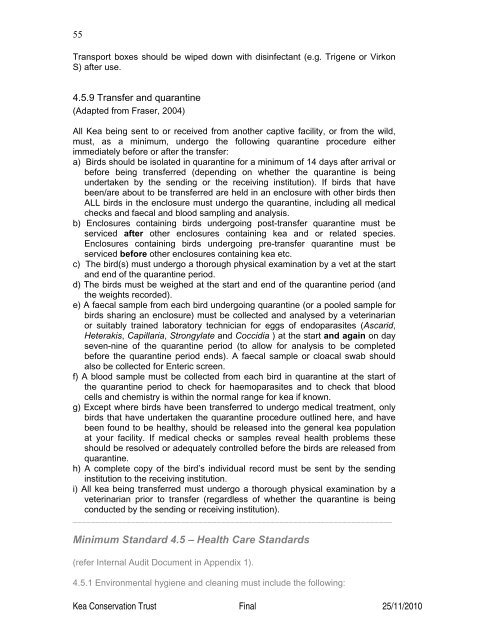(Nestor notabilis) Husbandry Manual - Kea Conservation Trust
(Nestor notabilis) Husbandry Manual - Kea Conservation Trust
(Nestor notabilis) Husbandry Manual - Kea Conservation Trust
You also want an ePaper? Increase the reach of your titles
YUMPU automatically turns print PDFs into web optimized ePapers that Google loves.
55<br />
Transport boxes should be wiped down with disinfectant (e.g. Trigene or Virkon<br />
S) after use.<br />
4.5.9 Transfer and quarantine<br />
(Adapted from Fraser, 2004)<br />
All <strong>Kea</strong> being sent to or received from another captive facility, or from the wild,<br />
must, as a minimum, undergo the following quarantine procedure either<br />
immediately before or after the transfer:<br />
a) Birds should be isolated in quarantine for a minimum of 14 days after arrival or<br />
before being transferred (depending on whether the quarantine is being<br />
undertaken by the sending or the receiving institution). If birds that have<br />
been/are about to be transferred are held in an enclosure with other birds then<br />
ALL birds in the enclosure must undergo the quarantine, including all medical<br />
checks and faecal and blood sampling and analysis.<br />
b) Enclosures containing birds undergoing post-transfer quarantine must be<br />
serviced after other enclosures containing kea and or related species.<br />
Enclosures containing birds undergoing pre-transfer quarantine must be<br />
serviced before other enclosures containing kea etc.<br />
c) The bird(s) must undergo a thorough physical examination by a vet at the start<br />
and end of the quarantine period.<br />
d) The birds must be weighed at the start and end of the quarantine period (and<br />
the weights recorded).<br />
e) A faecal sample from each bird undergoing quarantine (or a pooled sample for<br />
birds sharing an enclosure) must be collected and analysed by a veterinarian<br />
or suitably trained laboratory technician for eggs of endoparasites (Ascarid,<br />
Heterakis, Capillaria, Strongylate and Coccidia ) at the start and again on day<br />
seven-nine of the quarantine period (to allow for analysis to be completed<br />
before the quarantine period ends). A faecal sample or cloacal swab should<br />
also be collected for Enteric screen.<br />
f) A blood sample must be collected from each bird in quarantine at the start of<br />
the quarantine period to check for haemoparasites and to check that blood<br />
cells and chemistry is within the normal range for kea if known.<br />
g) Except where birds have been transferred to undergo medical treatment, only<br />
birds that have undertaken the quarantine procedure outlined here, and have<br />
been found to be healthy, should be released into the general kea population<br />
at your facility. If medical checks or samples reveal health problems these<br />
should be resolved or adequately controlled before the birds are released from<br />
quarantine.<br />
h) A complete copy of the bird’s individual record must be sent by the sending<br />
institution to the receiving institution.<br />
i) All kea being transferred must undergo a thorough physical examination by a<br />
veterinarian prior to transfer (regardless of whether the quarantine is being<br />
conducted by the sending or receiving institution).<br />
_______________________________________________________________________<br />
Minimum Standard 4.5 – Health Care Standards<br />
(refer Internal Audit Document in Appendix 1).<br />
4.5.1 Environmental hygiene and cleaning must include the following:<br />
<strong>Kea</strong> <strong>Conservation</strong> <strong>Trust</strong> Final 25/11/2010












